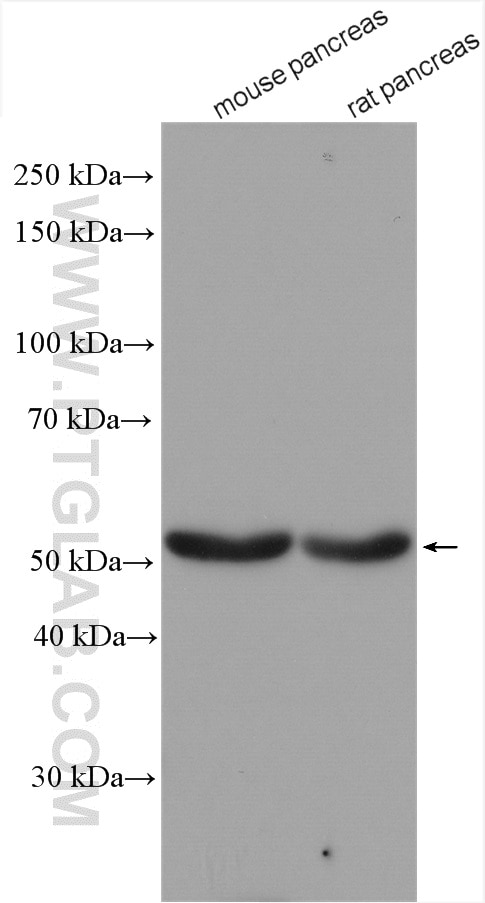- Phare
- Validé par KD/KO
Anticorps Polyclonal de lapin anti-GLP1R
GLP1R Polyclonal Antibody for IHC, WB, ELISA
Hôte / Isotype
Lapin / IgG
Réactivité testée
Humain, rat, souris
Applications
WB, IHC, IF, ELISA
Conjugaison
Non conjugué
N° de cat : 26196-1-AP
Synonymes
Galerie de données de validation
Applications testées
| Résultats positifs en WB | tissu pancréatique de souris, tissu pancréatique de rat |
| Résultats positifs en IHC | tissu pulmonaire de souris, il est suggéré de démasquer l'antigène avec un tampon de TE buffer pH 9.0; (*) À défaut, 'le démasquage de l'antigène peut être 'effectué avec un tampon citrate pH 6,0. |
Dilution recommandée
| Application | Dilution |
|---|---|
| Western Blot (WB) | WB : 1:500-1:2000 |
| Immunohistochimie (IHC) | IHC : 1:50-1:500 |
| It is recommended that this reagent should be titrated in each testing system to obtain optimal results. | |
| Sample-dependent, check data in validation data gallery | |
Applications publiées
| KD/KO | See 2 publications below |
| WB | See 14 publications below |
| IHC | See 1 publications below |
| IF | See 2 publications below |
Informations sur le produit
26196-1-AP cible GLP1R dans les applications de WB, IHC, IF, ELISA et montre une réactivité avec des échantillons Humain, rat, souris
| Réactivité | Humain, rat, souris |
| Réactivité citée | rat, Humain, souris |
| Hôte / Isotype | Lapin / IgG |
| Clonalité | Polyclonal |
| Type | Anticorps |
| Immunogène | GLP1R Protéine recombinante Ag23529 |
| Nom complet | glucagon-like peptide 1 receptor |
| Masse moléculaire calculée | 463 aa, 53 kDa |
| Poids moléculaire observé | 53 kDa |
| Numéro d’acquisition GenBank | BC112126 |
| Symbole du gène | GLP1R |
| Identification du gène (NCBI) | 2740 |
| Conjugaison | Non conjugué |
| Forme | Liquide |
| Méthode de purification | Purification par affinité contre l'antigène |
| Tampon de stockage | PBS avec azoture de sodium à 0,02 % et glycérol à 50 % pH 7,3 |
| Conditions de stockage | Stocker à -20°C. Stable pendant un an après l'expédition. L'aliquotage n'est pas nécessaire pour le stockage à -20oC Les 20ul contiennent 0,1% de BSA. |
Informations générales
GLP1R (glucagon-like peptide-1 receptor) is a G protein-coupled receptor belonging to the secretin receptor super-family, also known as class B (PMID:34911028). GLP1R is widely distributed in pancreatic islets, muscles, gastrointestinal tract, lung, liver, pancreas, and other tissues or organs (PMID:35989517). Moreover, GLP1R agonist has been reported to induce autophagy of EC (Endometrial carcinoma) cells, and high GLP1R expression may be associated with good prognosis of EC patients, suggesting that GLP1R is likely to participate in the progression of EC (PMID:29907137).
Protocole
| Product Specific Protocols | |
|---|---|
| WB protocol for GLP1R antibody 26196-1-AP | Download protocol |
| IHC protocol for GLP1R antibody 26196-1-AP | Download protocol |
| Standard Protocols | |
|---|---|
| Click here to view our Standard Protocols |
Publications
| Species | Application | Title |
|---|---|---|
Int J Mol Sci Geniposide Improves Diabetic Nephropathy by Enhancing ULK1-Mediated Autophagy and Reducing Oxidative Stress through AMPK Activation. | ||
Biomed Pharmacother Liraglutide, a glucagon-like peptide-1 receptor agonist, suppresses osteoclastogenesis through the inhibition of NF-κB and MAPK pathways via GLP-1R.
| ||
Front Pharmacol Novel Small Molecule Glucagon-Like Peptide-1 Receptor Agonist S6 Stimulates Insulin Secretion From Rat Islets. | ||
Front Pharmacol A Potential Mechanism Underlying the Therapeutic Effects of Progesterone and Allopregnanolone on Ketamine-Induced Cognitive Deficits. | ||
Front Endocrinol (Lausanne) Clozapine Induced Disturbances in Hepatic Glucose Metabolism: The Potential Role of PGRMC1 Signaling. | ||
Avis
The reviews below have been submitted by verified Proteintech customers who received an incentive forproviding their feedback.
FH Kenzo (Verified Customer) (08-16-2023) | This KO validated GLP-1R antibody generated specific robust signals in mouse pancreas tissue when used for immunofluorescence
|
FH Carly (Verified Customer) (11-17-2020) | Tested using EDTA plasma on an antibody microarray
|



